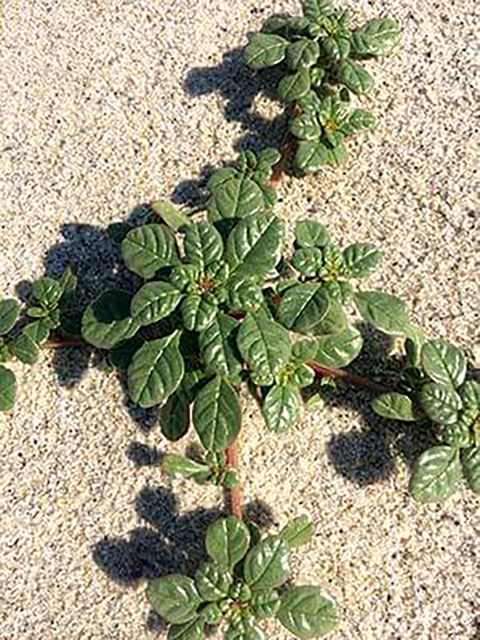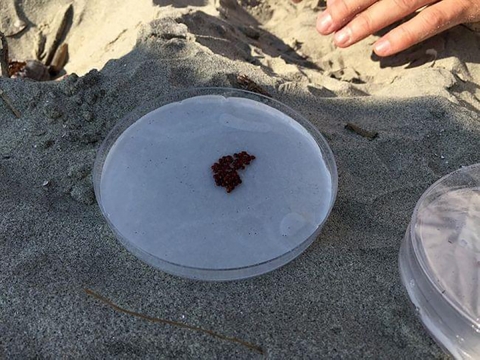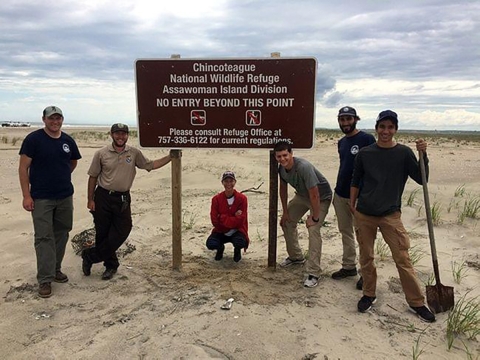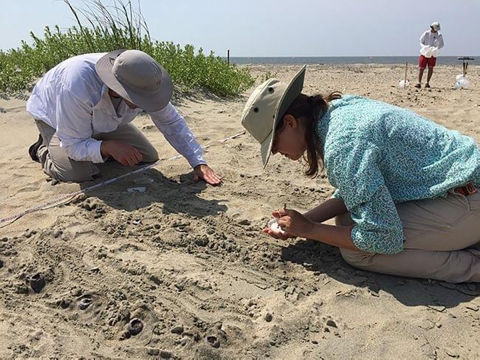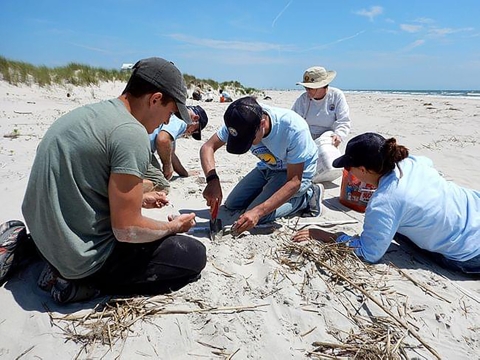First things first — the plant
Most people have probably never heard of seabeach amaranth, but for such an obscure little dune plant, it bears a mighty burden. This low-growing annual colonizes newly disturbed habitats such as over-wash areas at the end of barrier islands and flat, low-lying areas along the foremost dunes. It is perfectly designed for trapping sand and plays an important role in the dune-building process. As sand builds around the sprawling amaranth (some healthy plants can grow more than three feet in diameter), other plants move in, aiding in the establishment of dunes and eventually out-competing the amaranth. The amaranth moves on to new areas, and the cycle repeats. Because of this, seabeach amaranth is noted in the botanical world as a “fugitive” species.
Its ecological role cannot be overstated. The more sand that is trapped, the more vegetation can become established; the more stable the dunes, the more protected the beaches – you get the picture. It wouldn’t be a stretch to refer to seabeach amaranth as the Atlas of the beach-plant world, bearing the weight of coastal protection on its back.
Seabeach amaranth inhabits the dynamic shores of the Atlantic Coast, historically from Massachusetts to South Carolina, setting its roots wherever suitable habitat is available. First described in the early 1800s, it was frequently collected and written about. But by the 1900s with the advent of bulkheads and seawalls, the decline began. Increasing pressures on coastal habitats from development, human foot traffic, beach driving and such disastrous storms as Hurricane Hugo in 1989 sounded major alarms for the species, eventually resulting in its listing as a threatened species by the Service in 1993. Populations had declined to the point that the plant was only found in New York, North Carolina and South Carolina —Long Island being the northernmost population in existence. Since listing, additional threats have been identified such as beach nourishment projects, grazing by herbivores and invasive species invasive species
An invasive species is any plant or animal that has spread or been introduced into a new area where they are, or could, cause harm to the environment, economy, or human, animal, or plant health. Their unwelcome presence can destroy ecosystems and cost millions of dollars.
Learn more about invasive species .
Just like the environments in which seabeach amaranth grows, populations can be highly dynamic with numbers fluctuating widely from year to year. But something noteworthy has happened over the last decade, something more than just a fluctuation. A significant decline from a high of almost 250,000 plants tanked to just around 1,300 rangewide. Time to rally the troops.
The people
Dale Suiter, an endangered species biologist in the Service’s Raleigh Field Office, was behind the number crunching. As recovery lead for the species, he has kept up-to-date on seabeach amaranth populations since 2003. And being the lead for a species that historically spans nine states, he has had the opportunity to get to know quite a few folks who are working hard to recover this plant, including Erin King, biologist at Stewart B. McKinney National Wildlife Refuge in Connecticut. The two began to craft a rangewide recovery project to bolster the species. In short, the plan involved collecting seabeach amaranth seeds from existing populations and establishing seed plots on beaches at coastal refuges throughout the species’ historical range.
They realized that establishing more self-sustaining populations in natural areas less vulnerable to man-made threats was needed to prevent seabeach amaranth from going extinct.
A major component of the plan is a “seed increase” at the North Carolina Botanical Garden, the Center for Plant Conservation’s designated repository for seabeach amaranth seeds. An aging seabeach amaranth seed bank created an urgent need to collect new seeds from as many populations as possible to preserve genetic diversity, safeguard the species against extinction, and provide seeds for future research and reintroduction projects. The seed increase involved growing plants from seeds that were collected in the wild and then harvesting seeds from those plants. In total, 12,000 seeds went to establish seed plots in the field this season while an additional 80,000 seeds are being kept in long-term storage.
The places
.
The work began in May, first at Cape Romain National Wildlife Refuge in South Carolina and progressing northward to Chincoteague National Wildlife Refuge in Virginia, Cape May National Wildlife Refuge (and the adjacent U.S. Coast Guard LORAN Support Unit beach) and Edwin B. Forsythe National Wildlife Refuge in New Jersey, Nantucket National Wildlife Refuge (and lands owned by the Nantucket Conservation Foundation and the Massachusetts Trustees of Reservations) in Massachusetts and lastly Monomoy National Wildlife Refuge, also in Massachusetts With the help of two Service regions, six refuges, dozens of volunteers, partners and Service staff, one by one, the seeds were planted in carefully planned and plotted transects.
“This recovery project has been a great opportunity to work with other Service biologists and conservation partners to try to establish seabeach amaranth populations on national wildlife refuges and adjacent conservation lands,” says Suiter. “I’m eager to see the results of everyone’s hard work.”
And as the weeks passed, monitoring crews noted some amazing early success — beautiful, healthy seabeach amaranth plants springing up — some in places that haven’t seen plants in decades.
The hope is that as each of these plants will reach maturity and produce a wealth of seeds on the shores of these refuges, giving rise to a next generation of amaranth plants. From the beaches of Monomoy Refuge south to Cape Romain Refuge, this obscure little beach plant has gotten a hero’s welcome. Many of the people working this recovery project have never met face-to-face, but there is nevertheless a common thread connecting them all — faith in a tiny little seed that so many hands worked diligently to sow.
As Melanie Cucunato, an intern at Cape May Refuge, so eloquently says: “The only thing I can keep thinking is that in 20 years, when there is a steady seabeach amaranth population on the refuge, I will be able to visit and tell my children and my grandchildren, ‘I was a part of planting this seabeach amaranth and look at it now!’ I can’t think of anything more rewarding than that.”
The mission of the U.S. Fish and Wildlife Service is working with others to conserve, protect, and enhance fish, wildlife, plants, and their habitats for the continuing benefit of the American people. For more information on our work and the people who can make it happen, visit fws.gov. Connect with the Service on Facebook, follow our tweets, watch the YouTube Channel and download photos from Flickr.


